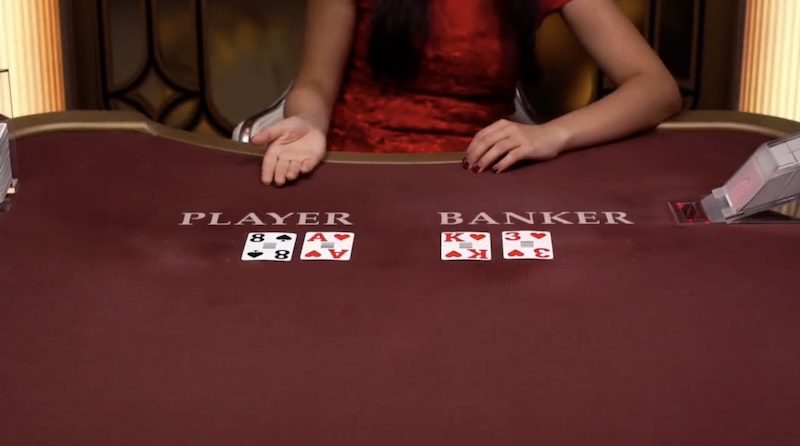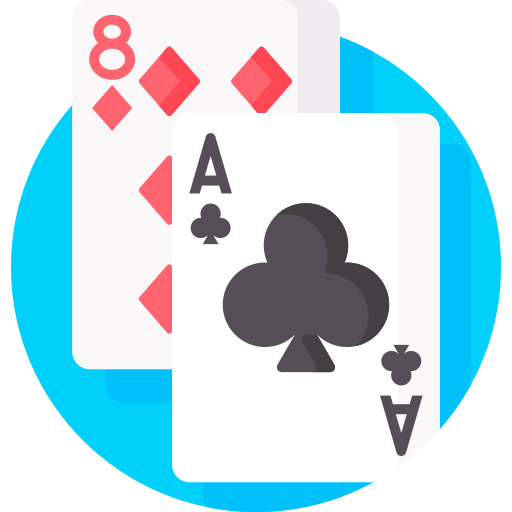
Baccarat Banque is a unique variation of the classic baccarat game, where one participant assumes the role of the banker. Unlike other baccarat versions, this format features two hands competing against the bank simultaneously. The game, which originated in France, remains a favorite in European casinos, particularly in Monaco. As with many high-stakes table games, Baccarat Banque shares the floor with other exciting live games such as Lightning Dice, which provide a fast-paced, immersive experience for players looking for a different kind of thrill.
Table Configuration and Setup
Baccarat Banque distinguishes itself with its distinct table layout and structural setup. The oval table is divided into two sections, accommodating up to 10 participants, five on each side. The banker is positioned at the center, opposite the dealer. This arrangement allows for the simultaneous play of two hands—one on the left and one on the right—both challenging the banker’s cards. The design promotes strategic betting, as participants can place wagers on one or both hands.
The game is played with three standard 52-card decks shuffled into a single shoe, adding complexity and unpredictability compared to variants using six or eight decks.
Key table roles include:
- The Banker: Located at the center, the banker is selected through an auction or by the individual willing to place the largest initial bet. They manage the central bank and compete against both hands.
- Participants’ Zones: Each side of the table has designated betting areas, numbered for organization and clarity.
- Betting Options: Wagers can be placed on the hand closest to the bettor, the hand on the opposite side, or both. The central stripe allows for bets involving both hands simultaneously.
- The Dealer: Also called the croupier, the dealer handles the cards and oversees the betting process.
How to Play Baccarat Banque
At its core, Baccarat Banque follows a similar premise to other baccarat variants: players aim to bet on the hand (either the player’s hands or the banker’s hand) that will have a value closest to 9. However, the twists and turns of this game make it a thrilling ride.
Card Values Explained
Before we delve into the gameplay, let’s brush up on the card values in Baccarat Banque:
| Card Type | Value |
| Numbered cards (2-9) | Worth their face value |
| Face cards (Jacks, Queens, Kings) | Worth 0 points |
| Aces | Worth 1 point |
If the total value of a hand exceeds 9, only the second digit is counted. For example, a hand containing a 9 and a 7 would have a value of 6 (9 + 7 = 16, and only the 6 is considered).
The Banker’s Role
One of the unique aspects of Baccarat Banque is the role of the banker. This coveted position is typically determined through an auction or by the player willing to put up the largest stake. The banker sits opposite the dealer and has the privilege (and risk) of playing against both player hands simultaneously.
Betting Procedures
Next, the betting phase begins. Players have the option to wager on either of the two player hands or the banker’s hand. If you wish to bet on both player hands simultaneously, you can place your bet on the center stripe running between the banker and the dealer.
The betting order follows a specific pattern, alternating between the players on the right and left sides of the table. Players can also choose to “go bank,” which means matching the banker’s entire stake. However, only one player per hand can “go bank,” and they get two more chances to win back their share if they lose.
The Deal
After the bets are placed, the game action begins. The banker deals one card face down to the player hand on their right, then to the player hand on their left, and finally to their own hand. This process is repeated once more, resulting in each hand having two cards.
If any hand is dealt a natural (a two-card total of 8 or 9), it is immediately revealed and compared. If no natural is dealt, players and the banker can decide whether to draw an additional card based on specific rules (more on that later).
Player Turns
Baccarat Banque progresses through a structured sequence of turns, with each side of the table playing in turn before the banker acts.
Player 1’s Turn
The action begins with the player seated in the first position to the right of the banker. This person, known as Player 1, represents the first group of players on that side of the table. If a player has “gone bank” by matching the banker’s stake, they will handle the cards for Player 1’s hand.
However, if no player has “gone bank,” the responsibility falls to one occupying the first seat. He examines their two-card hand and decides whether to stand or request an additional card based on specific rules:
| Hand Value | Action |
| 0 to 4 | Must draw a third card |
| 6 or 7 | Must stand |
| 5 | Option to draw or stand |
If Player 1’s hand results in a natural (8 or 9), the cards are immediately revealed, and the hand is compared to the banker’s hand.
Player 2’s Turn
Once Player 1’s turn is complete, the focus shifts to the opposite side of the table, where Player 2 represents the second group of players. The same rules apply as in Player 1’s turn, with the player in the corresponding first seat making the decision to stand or draw an additional card.
The Banker’s Turn
Finally, it’s the banker’s turn to play their hand. Unlike the players, his decisions are guided by a specific set of rules known as the “Banker’s Drawing Rules.” These rules dictate when he must draw a third card based on the values of their two-card hand and the third cards drawn by Player 1 and Player 2 (if applicable).
The banker must adhere to these rules, which take into account various scenarios and hand combinations. For instance, if the banker’s hand totals 0, 1, or 2, they must draw a third card. If the totals are 7, 8, or 9, they must stand.
Resolving Bets and Payouts
Once all hands have been played according to the established rules, it’s time to compare the values and determine the winners. The moment of truth arrives as the cards are revealed, and the croupier begins the process of settling the bets.
In Baccarat Banque, the payouts follow a simple structure:
- If you’ve correctly bet on the winning hand (either Player 1, Player 2, or the Banker), you’ll receive even money on your wager.
- In the event of a tie, where both the player’s hand and the banker’s hand have the same value, the bets on them are considered a push, and your stake is returned.
The croupier deftly manages the distribution of payouts, ensuring that every winning bet is rewarded and any losses are collected from the table.
Additional Rules to Keep in Mind
While the core mechanics of Baccarat Banque are straightforward, there are a few additional rules that add depth and strategy to the game:
- Betting Limits: The total sum of all players’ bets cannot exceed the banker’s stake for that particular hand. If the banker has placed a $5,000 bet, the combined bets from both player sections must not surpass that amount.
- Challenging the Banker: In a thrilling twist, players have the opportunity to challenge the current banker for their role. By announcing “Go bank” and matching the banker’s entire stake, a player can attempt to claim the coveted position. However, they only have three chances to succeed before losing the right to challenge again during that game.
- Banker’s Tenure: Unlike in Chemin de Fer, where the banker’s role is passed around with each loss, he in Baccarat Banque retains their position until the shoe has been fully played out or until they exhaust their funds and cannot continue betting.
Strategies and Tips for Baccarat Banque Mastery
While luck plays a role in Baccarat Banque, adopting the right strategies and tips can help you navigate the game with greater confidence and potentially improve your chances of success. Here are some key considerations:
- Understanding the Drawing Rules: Mastering the drawing rules for each hand is crucial in Baccarat Banque. As a player, you must familiarize yourself with when to stand or draw an additional card based on the value of your initial two-card hand. Consistently applying these rules can significantly impact your overall performance.
- Employing Betting Patterns: Seasoned players often utilize betting patterns or progressions to manage their bankrolls effectively. While no system guarantees wins, strategies like the Martingale or Fibonacci sequence can help you navigate the game’s ebbs and flows while maintaining a disciplined approach to betting.
- Observing the Banker’s Decisions: As a player, it’s beneficial to observe and understand the banker’s decision-making process. Pay attention to the specific rules that govern when the banker must draw or stand, as this knowledge can inform your betting decisions and help you anticipate the potential outcomes of each hand.
The Pros and Cons of Baccarat Banque
Like any casino game, Baccarat Banque has its advantages and drawbacks. Here’s a quick overview to help you weigh the pros and cons:
| Pros | Cons |
| Unique and engaging gameplay | Often limited to high-rollers |
| Opportunity to become the banker | House edge can be significant |
| Strategic betting options | Challenging to find online variants |
| Intense player-versus-banker dynamic | Limited availability in land-based casinos |
FAQs
Can players challenge the current banker?
In Baccarat Banque, players have the opportunity to challenge the current banker for their coveted role. By declaring “Go bank” and matching the banker’s entire stake, a player can attempt to claim the banking position. However, this challenge is not without its limitations – players only have three chances to succeed before losing the right to challenge again during that particular game.
What happens if the banker’s funds run out?
The role of the banker in Baccarat Banque is a prestigious one, but it also carries risk. If the banker exhausts their funds and can no longer continue betting, the game dictates that the role must be passed on to another player willing to put up the largest stake. This ensures that the game can progress smoothly, even in the face of depleted banker resources.
Are there any specific drawing rules for the banker?
Yes, the banker must follow a set of predetermined rules known as the “Banker’s Drawing Rules,” which dictate when they must draw or stand based on the values of their hand and the player’s hands.
What sets Baccarat Banque apart from other baccarat variants?
The key distinction of Baccarat Banque lies in the banker’s role. Unlike traditional baccarat games, one player assumes the role of the banker and plays against two separate player hands simultaneously, creating a unique dynamic.
Is it possible to play Baccarat Banque online?
Unfortunately, finding online variants of Baccarat Banque can be quite challenging. While it is still played in some European land-based casinos, particularly in renowned gambling destinations like Monaco, most online casinos tend to offer more widely popular baccarat variants such as Punto Banco or Chemin de Fer. The availability of Baccarat Banque in the digital realm is relatively limited.
